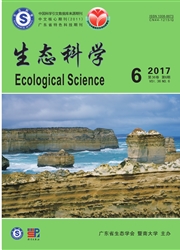

 中文摘要:
中文摘要:
为了解华南地区深水水库中枝角类休眠卵在底泥中的种群特征,于2009年2月对广东省流溪河水库沉积物中的枝角类休眠卵种类、数量和分布进行研究。在湖泊区、过渡区和河流区共设置8个采样点,采集表层15cm柱状底泥,经600、200和35μm三种孔径的网筛分离休眠卵后显微镜下计数。15cm样品根据柱状底泥的纹层确定为18~24年的沉积物。共检出12种枝角类休眠卵,河流区采样点未检出,两条入库河流汇合区种类数为10,其余采样点有4至5种。15cm沉积物中休眠卵的平均密度为1.3×105ind·m3。休眠卵的多样性及密度分布特征与生境相关,过渡区底泥中的多样性高于湖泊区,但湖泊区底泥中密度高。卵库中的优势种类为微型裸腹溞(Moinamicrura)、船卵溞属(Scapholeberissp.)和溞属(Daphniasp.),均为逃避能力弱的种类。流溪河位于热带北缘,水温常年较高,多数枝角类可通过孤雌生殖终年存在于水体中,导致休眠卵的种类数量与密度均明显地低于温带湖泊。
 英文摘要:
英文摘要:
In order to understand the population characteristics of cladoceran resting eggs in deep reservoirs in southern China, we investigated their species composition, density, and distribution in surface sediments (0-15 cm) collected from Liuxihe Reservoir in Feburary 2009. Sediment cores were taken at eight sites, and the top 15 cm sediments were sampled and washed through 600, 200 and 35-prn meshes, respectively. These sediment core-tops were accumulated in 18 to 24 years according to annual lamination. Among the 12 types of resting egg identified, the highest species richness (10) was observed at the confluence of two influent rivers, in contrast to other sampling sites (mostly 4 or 5). Average density was 1.34×10^5 ind.. m3. The distribution pattern in diversity and density seems to relate to habitat diversity, with higher diversity but lower density at the transition zone than at the lacustrine zone. The three dominant species are Moina micrura, Daphnia sp., and Scapholeberis sp., all having a weak ability against fish predation. As Liuxihe Reservoir is located at the north bounadry of the tropic, high water temperatures enable cladocera to maintain an active popualtion solely through parthenogenesis, resulting in significantly lower species number and density than in temperate lakes.
 同期刊论文项目
同期刊论文项目
 同项目期刊论文
同项目期刊论文
 Predation pressure induced by seasonal ?shing moratorium changes the dynamics of subtropical Cladoce
Predation pressure induced by seasonal ?shing moratorium changes the dynamics of subtropical Cladoce 期刊信息
期刊信息
